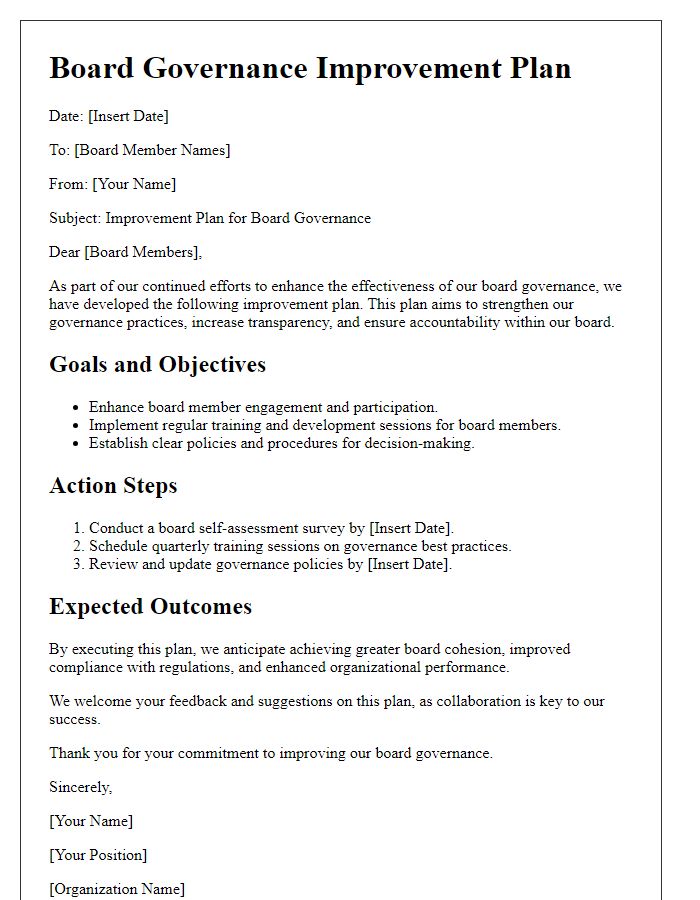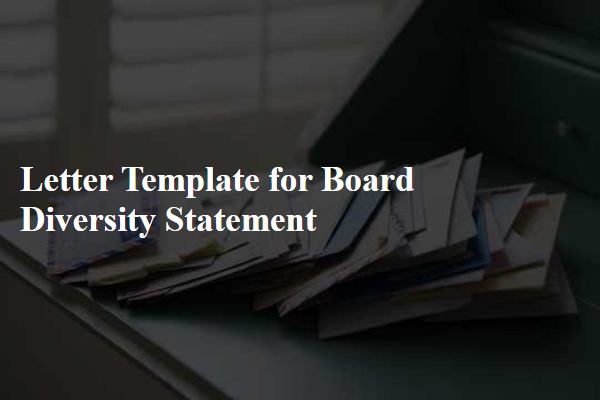Are you looking to enhance your board's governance practices? Crafting a letter that outlines key aspects and insights can set a positive tone for your upcoming reviews. By clearly communicating your objectives and inviting dialogue, you create a collaborative atmosphere that fosters improvement. Let's dive deeper into how to effectively structure your governance review letter to achieve maximum impact!

Purpose and objectives of the board governance review.
The board governance review serves a critical purpose in enhancing the effectiveness and accountability of an organization's leadership structure. This review aims to evaluate existing governance practices, ensuring alignment with best practices and regulatory requirements specific to the nonprofit sector. Key objectives include assessing the board's composition, diversity, and skills, as well as examining the roles and responsibilities outlined in the bylaws. The review will identify areas for improvement in decision-making processes, transparency, and stakeholder engagement, ultimately fostering a stronger governance framework that supports strategic goals. Additionally, the review seeks to gather feedback from board members and stakeholders, facilitating a culture of continuous improvement and adaptive governance.
Key areas of focus and assessment criteria.
During the board governance review process, several critical areas of focus emerge, including board composition, policies, and overall effectiveness in decision-making. Board composition entails evaluating the diversity and expertise of board members, ensuring representation from various backgrounds such as finance, law, and industry-specific experience. Policies must be scrutinized for compliance with regulatory standards and best practices, such as the Sarbanes-Oxley Act for public companies, which emphasizes transparency and accountability. Effectiveness in decision-making is assessed through performance metrics, including the frequency of successful strategic initiatives and stakeholder engagement levels. Regular self-assessments, such as the use of governance scorecards, facilitate a comprehensive evaluation of the board's performance across these key areas, ensuring alignment with organizational goals and stakeholder expectations.
Timeline and process for conducting the review.
The timeline for conducting the board governance review is set over a three-month period. Initial preparations (including document gathering and stakeholder interviews) are scheduled for the first month, allowing sufficient time for comprehensive data collection from board members, industry best practices, and governance frameworks. The second month is dedicated to analysis and evaluation, where collected information will be assessed against established governance standards such as the OECD Principles of Corporate Governance. The review culminates in the third month with the drafting of the final report, incorporating recommendations and strategic adjustments, which will be presented to the board for discussion and decision-making. Regular check-in meetings will occur bi-weekly to ensure all parties remain aligned and informed throughout the entire review process.
Roles and responsibilities of involved parties.
Effective board governance review involves defining the roles and responsibilities of key stakeholders within an organization, such as board members, executive leadership, and committees. Board members must fulfill fiduciary responsibilities by ensuring compliance with relevant laws and regulations while providing strategic oversight. Executive leadership, including the CEO and senior management team, is responsible for the implementation of board policies and operational excellence. Committees, such as the audit or compensation committee, play a crucial role in specific areas of governance, conducting detailed reviews, and reporting findings to the full board. This collaborative framework, supported by clear charters and accountability mechanisms, promotes transparency and strengthens organizational integrity, particularly during critical governance assessments or compliance audits.
Confidentiality and reporting protocols.
Confidentiality in board governance is crucial for maintaining trust and integrity within organizations. Procedures should align with established policies governing sensitive information, ensuring that all board members understand their legal obligations under regulations such as the Sarbanes-Oxley Act. Reporting protocols must include clear guidelines on how to handle breaches of confidentiality, including escalation paths to the audit committee or external regulators like the Securities and Exchange Commission (SEC). Additionally, regular training sessions should be scheduled to reinforce these protocols, highlighting case studies of breaches in well-known companies like Enron to illustrate risks. Documentation of all procedures should be securely maintained, accessible only to authorized personnel, enhancing an organization's commitment to transparency while safeguarding its confidential information.













Comments